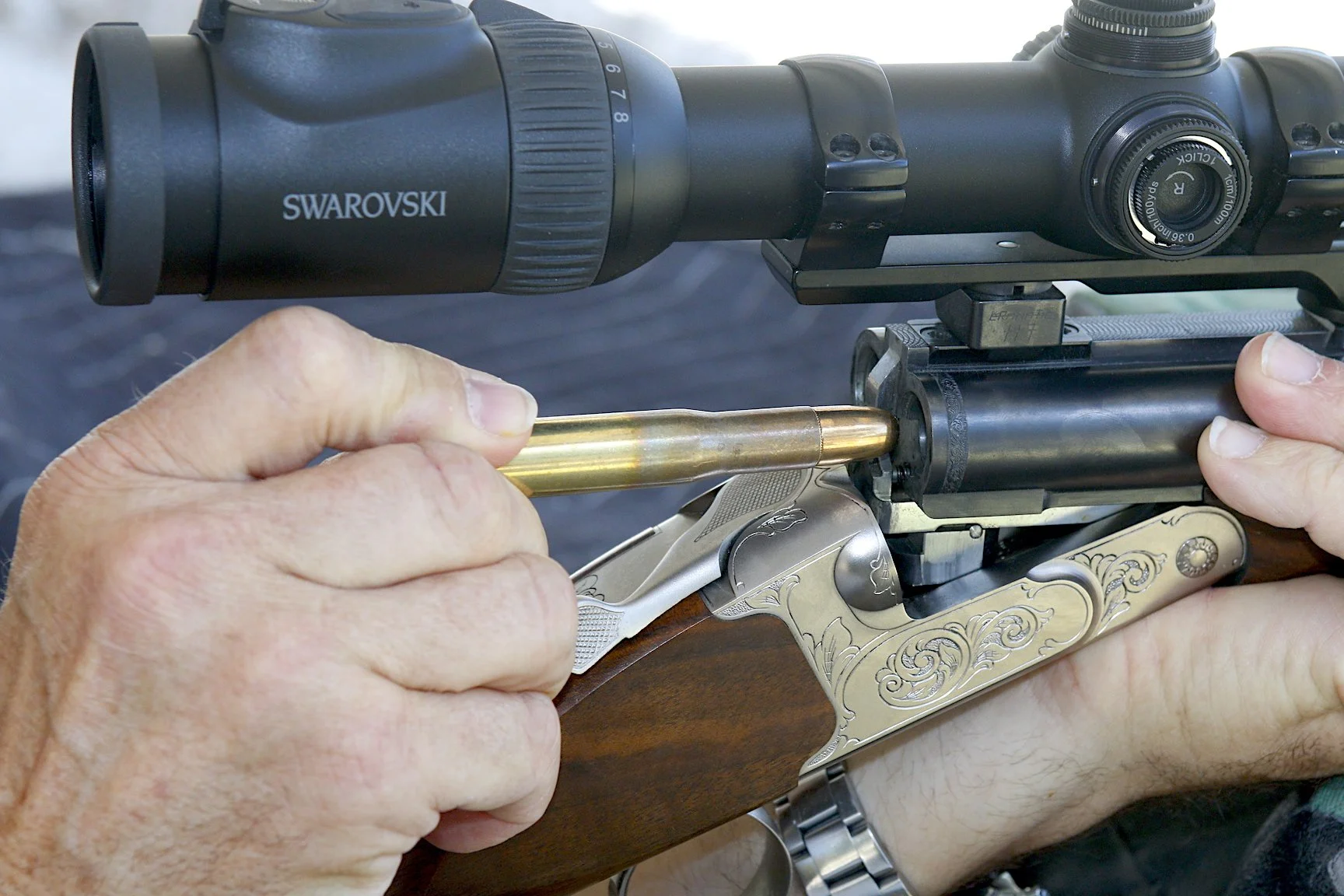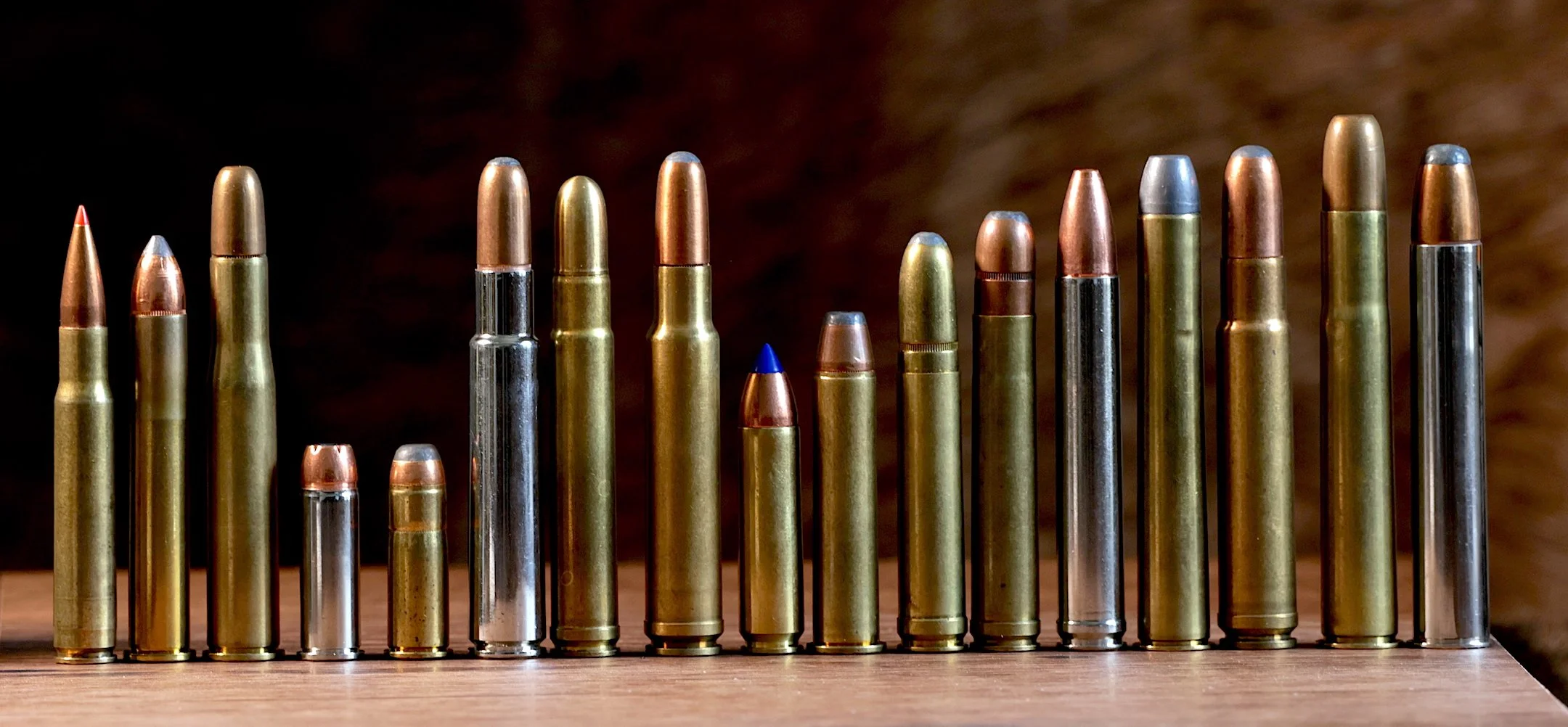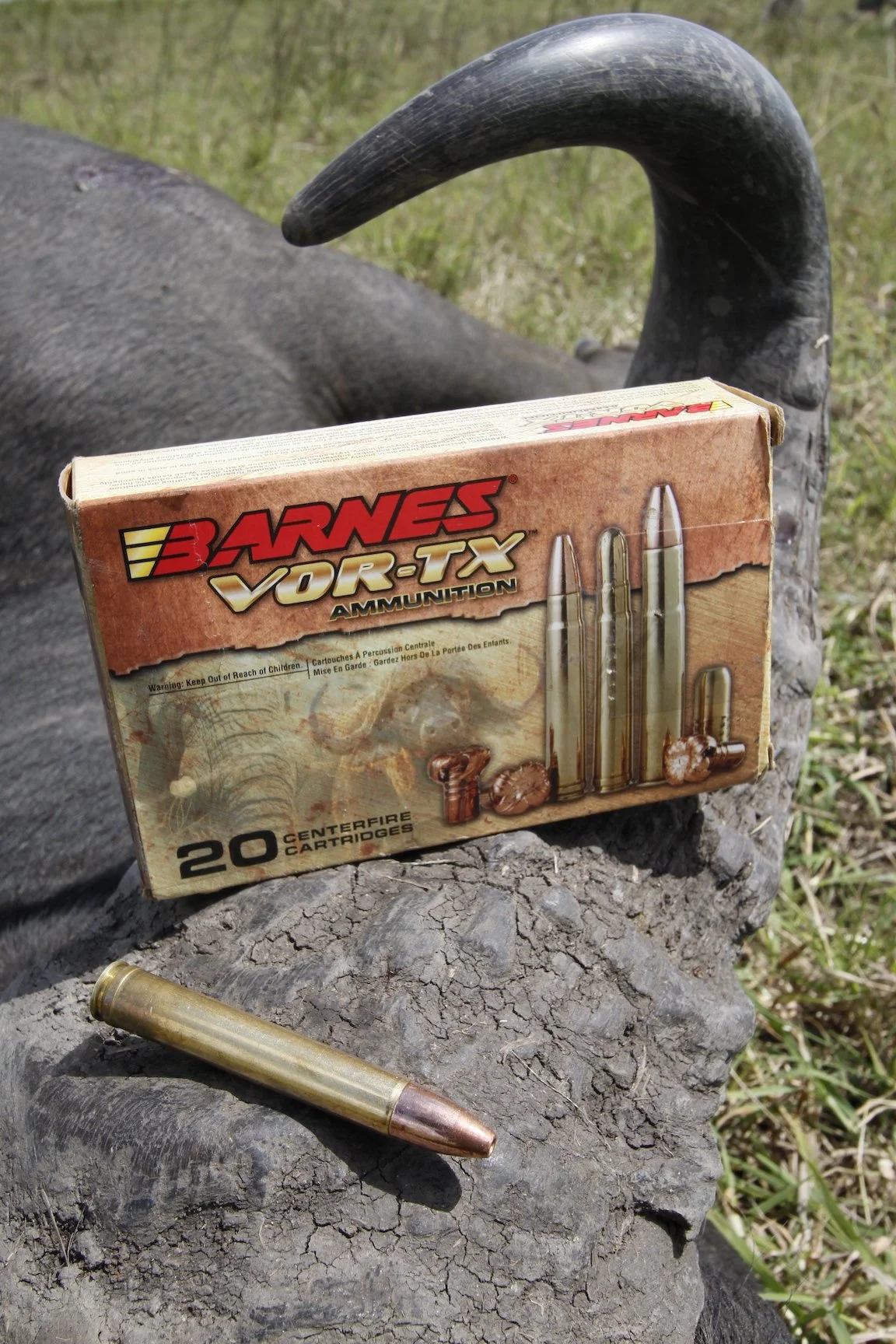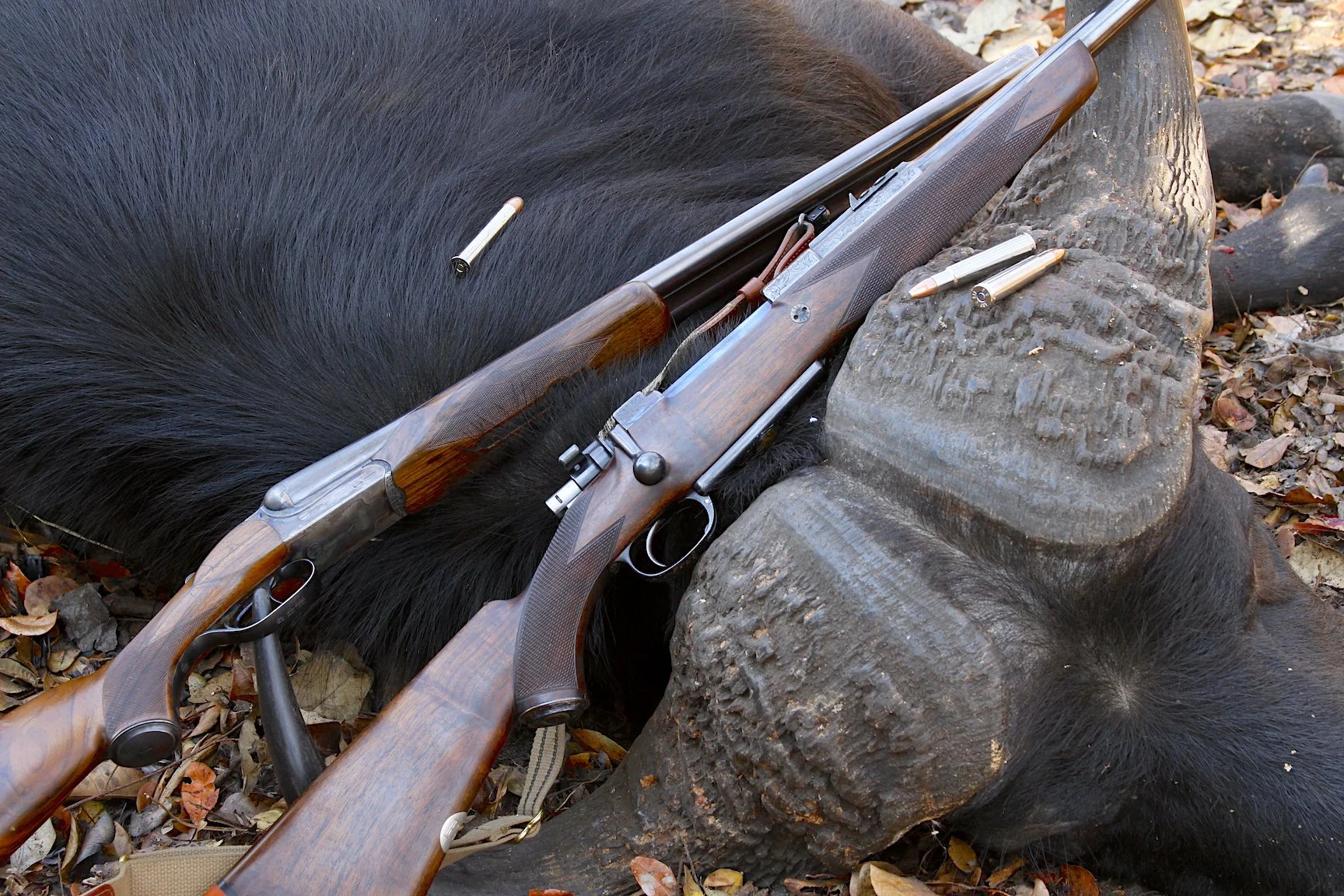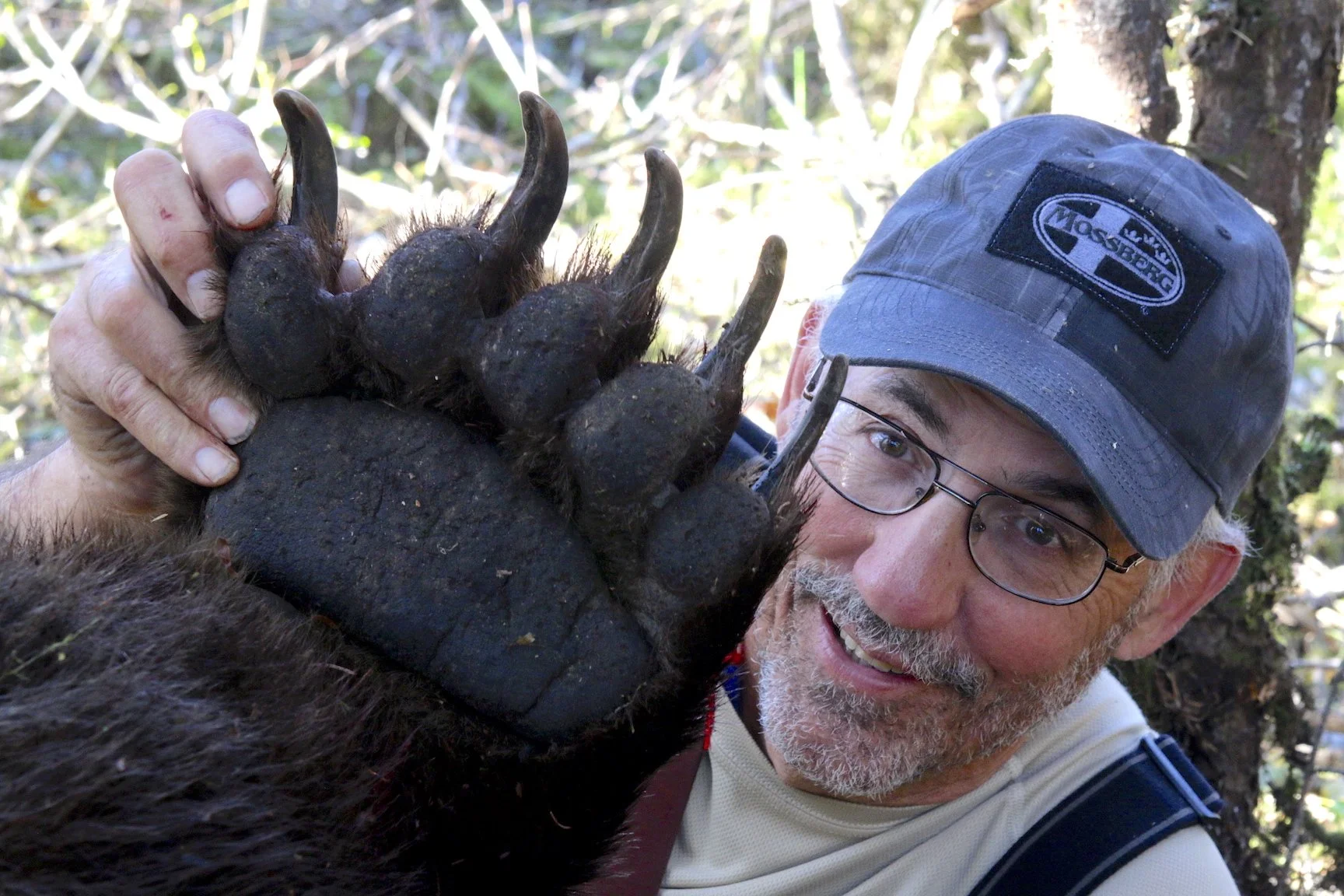Why Big Bore Cartridges are Not That Popular
For every rifle chambered in 45-70 Govt. there must be 1,000 build in 223 Remington. For every 458 Winchester Magnum there must be 10,000 6.5 Creedmoors. Why aren’t the 40 calibers and larger more popular?
Price and need. The typical elk and deer hunter doesn’t need a big 40, 45, or 50 to handle the work. And few of us want to pay the price in rifles, ammo, and recoil for shooting a big bore.
So then why have them? Why are there some two dozen big bore cartridges made and sold in the US of A?
Fun. Curiosity. Bears and buffalo, I think. Those reasons and a bit of nostalgia and desire to impress oneself and one’s friends.
Meet the Big Bores
Not all big bores are created equal. And not all are dangerous game hammers. Many don’t produce as much muzzle energy at the 30-06 on far left. L. to R. are: 405 Win., 450/400, 44 Rem Mag., 44-40 Win., 416 Rigby, 416 Rem. Mag., 416 Wby. Mag., 450 Bushmaster, 45-70 Govt., 450 Marlin, 458 Win. Mag., 458 Lott, 450 Nitro Express, 460 Wby. Mag., 470 Nitro Express, and 500 Nitro Express.
There is no hard and fast definition of a big bore, but we’re pretty safe starting with 40-caliber and clawing up the scale to the 50-caliber. And then throwing in the two novelty rounds, the 600 Nitro Express and 700 Nitro Express. But this doesn’t perfectly define all the big bores, either.
Consider the 44-40 Winchester, the original centerfire big bore. Yes, the .427-inch bullet diameter is what most consider a “big bore,” but at 1,190 fps and 629 f-p of muzzle energy, hardly what most of us expect. The more modern 44 Rem. Mag. revolver cartridge betters that, nudging a 240-gr .430” bullet 1,600 fps for 1,507 f-p. Those numbers aren’t all that impressive, either. Big bores are supposed to be powerful and hard hitting like the famous old 45-70 Govt. Now there’s some bear stopping potential…
Uh, sorta kinda? Our 1873 war horse at factory-loaded pressures spits a 300-gr. flat nose 1,880 fps on a good day. That’s enough to cough up 2,355 f-p muzzle energy. Sound like a sledge hammer? A 180-gr. from a common 30-06 puts out 3,023 f-p. It’s sectional density is appreciably higher than the 300-gr. .458 slug, too. SD of .271 vs. .204.
Despite its reputation as a thumper, this 45-70 Govt. in a fine Model 95 Marlin needed three 300-gr. Barnes TSX slugs to the chest to stop this warthog. Big bores aren’t magic.
The little 450 Bushmaster hits harder than the 45-70, kicking up 2,404 f-p when driving the same 300-gr. bullet. The seldom-heard-from 450 Marlin does better with 3,427 f-p thanks to its higher allowed max chamber pressures. Even the slightly narrower 444 Marlin with a little 240-gr. slug comes up with 2,942 f-p at 2,330 fps.
Let’s Get Big Bore Serious
To step into the real world of big bores we need to start with the 416 Rem. Mag. or 458 Win. Mag. These are powerhouses in the tradition of the old British buffalo, rhino, and elephant rounds, true hammers that send closer to 5,000 f-p energy downrange. The 458 Win. Mag., this country’s first dangerous game big bore way back in 1956, was supposed to drive a 500-gr. slug 2,100 fps to match the 5,000 f-p energy of the old 450 Nitro Express. It was hard pressed to do it, so one Jack Lott reversed Winchester’s case shortening back to the standard magnum length, enough room for enough powder to slam that 500-gr. bullet 2,300 fps from the muzzle for 5,872 f-p energy. With today’s better powders, the 458 Win. Mag. is reliably hitting 2,040 fps for 4,620 f-p energy. Thanks to convenience and price, it’s quite popular across Africa.
Sometimes it takes a Lott to lay low a buffalo. Barnes TSX 500-gr. slugs from a Blaser R8 in 458 Lott took care of this Zambeze Delta Safaris buffalo with one shot.
Now we’re in the realm of the real dangerous game big bores. The only other in the all-American melting pot are the 416 Remington and 416 Ruger hitting 5,115 f-p with 400-gr. bullets at 2,400 fps; the 416 Wby. Mag. adding 300 fps to that launch speed for 6,474 f-p of hammer; and the insane 460 Wby. Mag. coughing up a 500-gr. solid at 2,600 fps for a jaw breaking 7,507 f-p.
To put those in perspective, consider the near mythical 50-90 Sharps blackpowder round. This infamous bison slayer was slamming 1,800-pound bison to the prairie with 550-gr. cast lead bullets going 1,450 fps. But that meant they were carrying just 2,568 f-p energy. Obviously this was more than enough, given the near extinction of the bison, but it’s enlightening to discover this old pounder didn’t put out as much energy as a 30-06. Of course, 550-grains of lead are harder to slow down than 180-grains of lead. Momentum matters.
The big Sharps buffalo cartridges worked beautifully on bison, but not via massive knockdown energy. A big hole through the plumbing brought on a gradual demise. This heart-shot bull bled out in about 30 seconds.
Big Bores of a Dangerous Game Empire
We would be remiss to end this investigation without mentioning some of the famous British dangerous game cartridges that established this category. Because the Brits in their far flung colonies found themselves called upon to stop lions and tigers and recalcitrant rhinos and elephants from terrorizing villagers and settlers alike, they experimented with smokeless powder and jacketed bullets to improve the limited performance of their old 8, 4, and 2 gauge guns. The increased energy inherent in smokeless powder meant they could slim down to .577, .50, .45, and even .41 diameters and best the performance of the old guns. Thus emerged such icons as the 500 Nitro Express, 470 Nitro Express, 450 3 1/4-inch Nitro Express, 505 Gibbs, and even the 600 Nitro Express. All of these and others threw 400- to 525-gr. bullets 2,100 fps to 2,400 fps to reach muzzle energies of 5,000 to 6,000 f-p or so. The 600 N.E. was the wildcard, more of a novelty than necessity coughing up 8,400 f-p energy with a 900-gr. bullet at 2,050 fps. The 700 Nitro Express was an afterthought designed to win a “biggest ever” contest, not go hunting.
The author’s 416 Rigby tamed this buffalo with one 400-gr. Swift A-Frame. The PH contributed to the British double by adding an anchoring 500-gr. from his Rigby 450 N.E. double rifle.
Rare Rifles with Rare Punishment
Rifles chambered for such punishing rounds are uncommon because of that punishment — or at least the threat of it. Few want to withstand the kick of a big bore or pay the price in carry weight of a rifle properly scaled to moderate it. Even in a 13-pound platform, most of these serious big bores will jump with 50- to as many as 80 f-p of recoil. Make the mistake of building a 13-pounder in 600 N.E. and it’ll knock you upside the chin with 145.8 f-p of recoil!
The other blow wallops your credit card. Massively large cartridges burning two to three times more powder than a typical mid-caliber deer cartridge. Throwing three to four times more bullet will set you back about $10 a shot.
Get Your Big Bore for Bear Protection and Safari
Obviously your typical deer hunter isn’t entertaining a big bore dangerous game rifle, but serious riflemen looking to expand their horizons and, perhaps, defend hide and hair against irascible grizzlies or safari to Cape buffalo country for an altercation with a bull, find themselves deeply interested in the life and times of dangerous game big bores. Perhaps you are one of us.
Preventing one of these from reaching your face is a fine excuse for owning a dangerous game big bore rifle.


